PSA conducts the 2024 Data Dissemination Forum on International Merchandise Trade Statistics
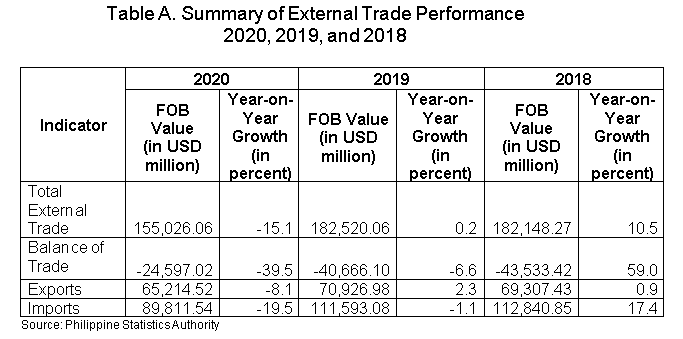
A. TOTAL EXTERNAL TRADE AND BALANCE OF TRADE
1. Total external trade dropped
The country’s total external trade in goods plunged to USD 155.03 billion in 2020, from USD 182.52 billion in 2019. This indicates an annual decline of -15.1 percent in 2020. In 2019, total trade grew by 0.2 percent while in 2018, total trade increased at annual rate of 10.5 percent. (Table A)
Of the total external trade, 57.9 percent were imported goods and the rest were exported goods.
2. Trade deficit declined at a faster rate
Balance of trade in goods (BoT-G) is the difference between the value of export and import. BoT-G in 2020 was USD -24.60 billion which represents a trade deficit with an annual decline of -39.5 percent. The drop in trade deficit during 2020 was faster than the year-on-year decline of -6.6 percent in 2019. On the contrary, trade deficit grew at an annual rate of 59.0 percent in 2018. (Figure 1 and Table A)
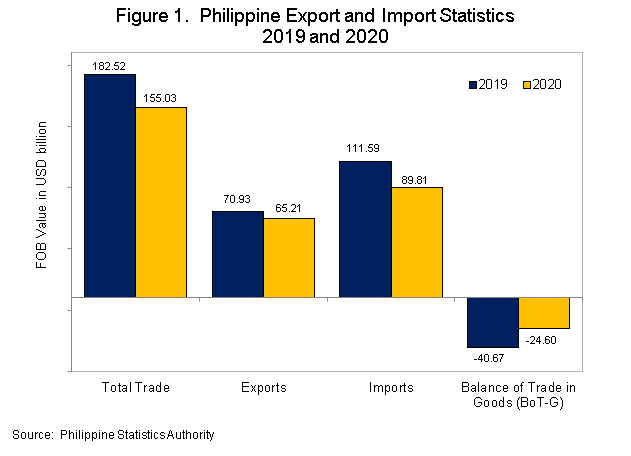
B. EXPORTS
1. Export value posted negative growth
The country’s total export sales in 2020, amounting to USD 65.21 billion, decreased at an annual rate of -8.1 percent, from the USD 70.93 billion total export sales in 2019. The annual rate of export earnings climbed to 2.3 percent in 2019 and 0.9 percent in 2018. (Figure 2 and Table A)
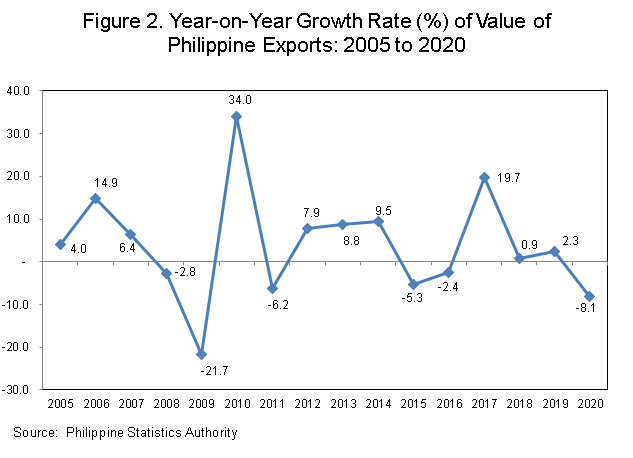
Of the top 10 major commodity groups in terms of value of exports, eight recorded annual decreases led by metal components (-18.8%); ignition wiring set and other wiring sets used in vehicles, aircrafts and ships (-18.6%); and machinery and transport equipment (-16.3%). (Tables B and 2)
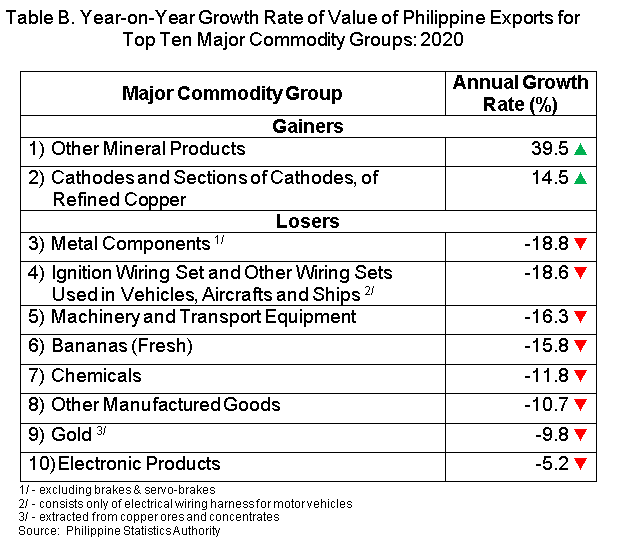
2. Electronic products commodity group remained the highest on export sales
By commodity group, exports of electronic products continued to be the country’s top export with total earnings of USD 37.95 billion in 2020. This amount accounted for 58.2 percent of the total exports in 2020. This was followed by other manufactured goods, valued at USD 3.60 billion (5.5%); and machinery and transport equipment which amounted to USD 2.25 billion (3.4%). (Figure 3 and Table 2)

3. Manufactured goods commodity group still comprised the biggest chunk of total exports
By major type of goods, exports of manufactured goods shared the highest to the total exports in 2020, amounting to USD 53.78 billion (82.5%). This was followed by mineral products which contributed USD 5.09 billion (7.8%); and total agro-based products with a share of USD 4.78 billion (7.3%). (Figure 4 and Table 5)
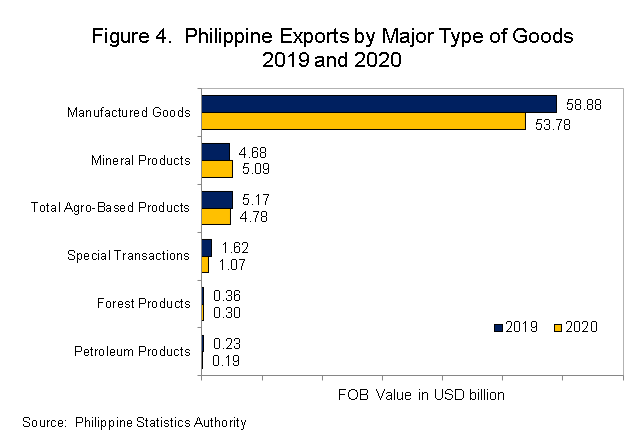
4. Japan contributed the highest export value
By major trading partner, exports to Japan comprised the highest export value amounting to USD 10.03 billion or a share of 15.4 percent to the total exports in 2020.
Completing the top five major export trading partners with their export values and percent shares to the total exports were:
a. United States of America (USA), USD 10.02 billion (15.4%);
b. People’s Republic of China, USD 9.83 billion (15.1%);
c. Hong Kong, USD 9.23 billion (14.1%); and
d.Singapore, USD 3.77 billion (5.8%). (Figure 5 and Table 4)
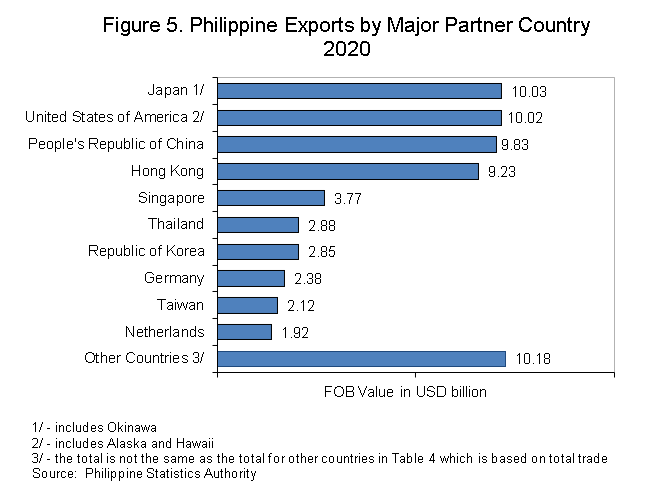
5. Germany topped total exports among EU member countries
Exports to European Union (EU) reached USD 6.95 billion or 10.7 percent of the total export receipts in 2020. Revenue from exports to Germany had the highest share of USD 2.38 billion or 34.2 percent of the total exports to EU member countries. (Figure 6 and Table 9)
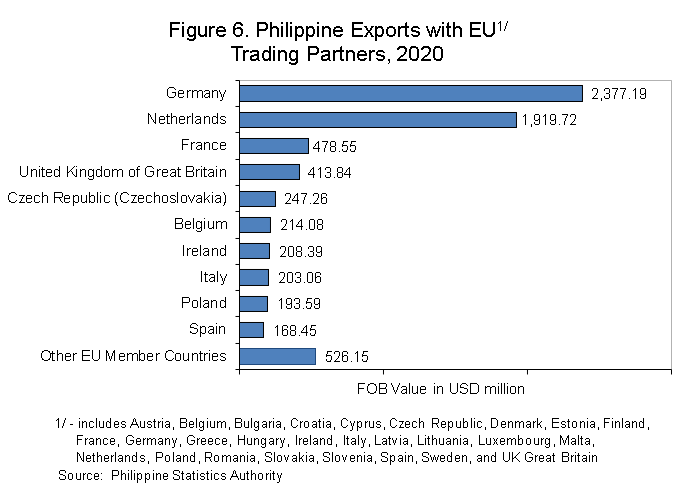
The top five exported goods to EU member countries with their export receipts and percent shares to the total EU exports were:\
a. electronic products, USD 4.49 billion (64.6%);
b. coconut oil, USD 384.95 million (5.5%);
c. other manufactured goods, USD 318.24 million (4.6%);
d. tuna, USD 279.64 million (4.0%); and
e. machinery and transport equipment, USD 256.30 million (3.7%). (Table 10)
6. Singapore led the ASEAN member countries in terms of total exports
Total exports to Association of Southeast Asian Nations (ASEAN) member countries reached USD 10.24 billion or 15.7 percent of the country’s total exports in 2020.
Exports to Singapore accounted for the highest share of USD 3.77 billion or 36.8 percent of the total exports to ASEAN member countries. (Figure 7 and Table 9)
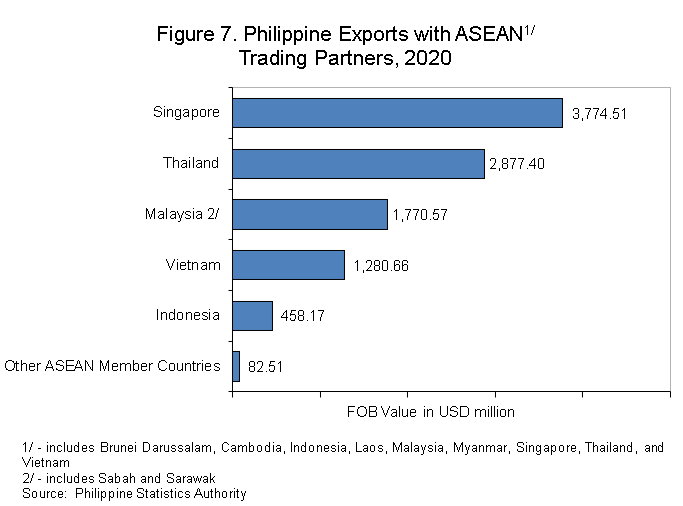
7. Japan topped exports among APEC member countries
Export receipts to Asia Pacific Economic Cooperation (APEC) member countries amounted to USD 55.79 billion or 85.5 percent of the total exports in 2020.
Export receipts to Japan stood as the highest total export valued at USD 10.03 billion or 18.0 percent of the country’s total exports to APEC member countries. (Figure 8 and Table 12)
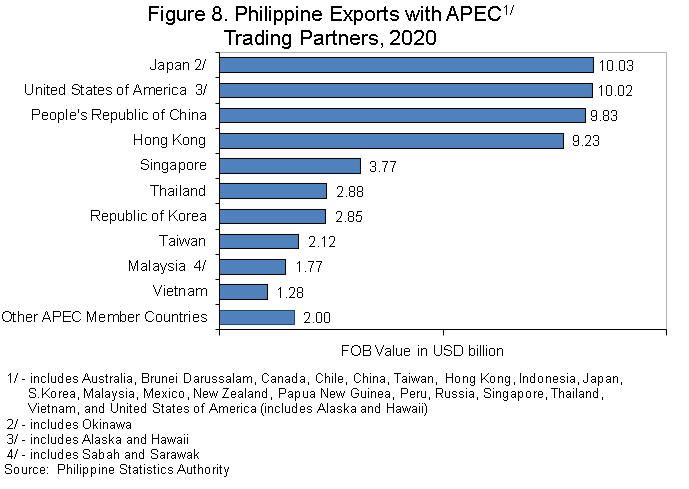
The top five exported goods to APEC member countries and their corresponding export sales and percent shares to the total APEC exports were:
a. electronic products, USD 32.90 billion (59.0%);
b. other manufactured goods, USD 3.04 billion (5.4%);
c. other mineral products, USD 2.00 billion (3.6%);
d. machinery and transport equipment, USD 1.93 billion (3.5%); and
e. ignition wiring set and other wiring sets used in vehicles, aircrafts and ships, USD 1.85 billion (3.3%). (Table 13)
8. Eastern Asia contributed the highest export value by geographic region
By geographic region, Eastern Asia comprised the highest export value amounting to USD 34.08 billion in 2020. This was followed by Northern America with an export value of USD 10.42 billion and South-eastern Asia which amounted to USD 10.24 billion. (Figure 9)
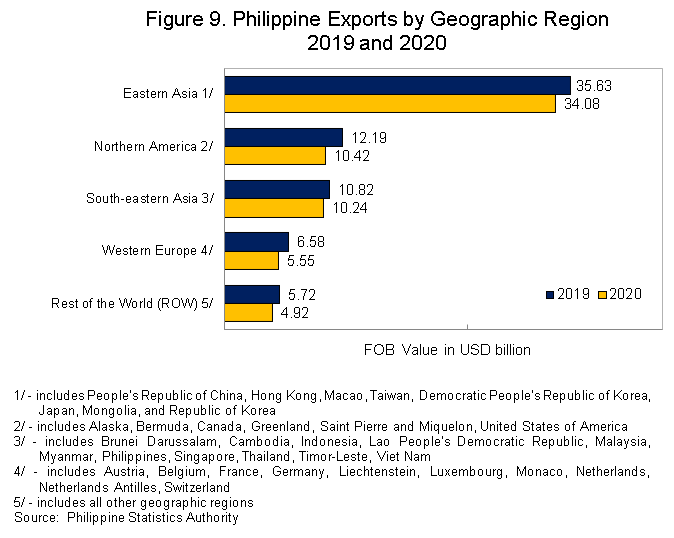
C. IMPORTS
1. Import value continued to drop
The total imported goods in 2020, which amounted to USD 89.81 billion, plunged at an annual rate of -19.5 percent. In 2019, the annual decline was recorded at -1.1 percent while in 2018, total import value grew by 17.4 percent. (Figure 10 and Table A)
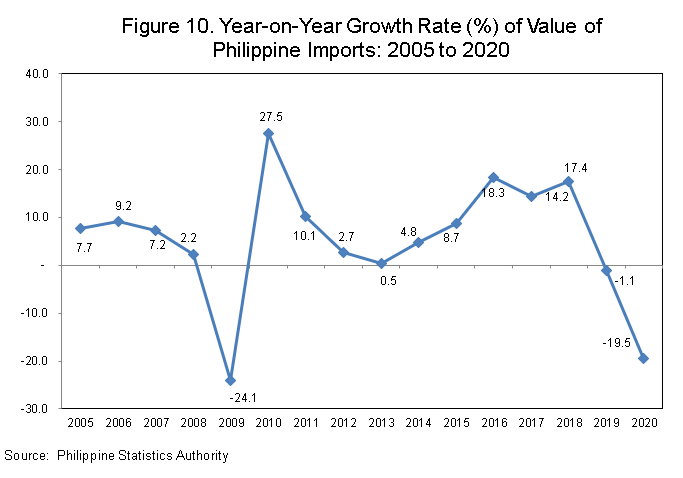
The decrement of imported goods in 2020 was due to the decrease in all of the top 10 major commodity groups. The decline in annual rate was fastest in transport equipment (-45.0%); mineral fuels, lubricants and related materials (-42.9%); and industrial machinery and equipment (-26.4%). (Tables C and 3)
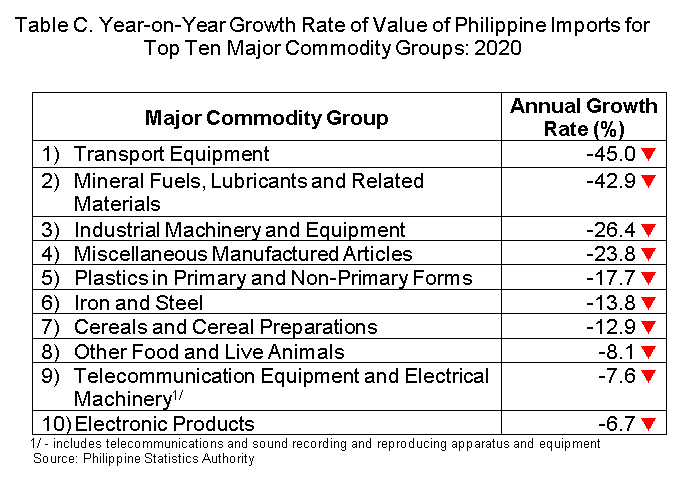
2. Electronic products accounted for the highest import value among commodity groups
Most of the imported goods were electronic products with an import value of USD 26.64 billion or a share of 29.7 percent to the total imports in 2020. This was followed by mineral fuels, lubricants and related materials, valued at USD 7.64 billion (8.5%); and transport equipment which amounted to USD 6.36 billion (7.1%). (Figure 11 and Table 3)
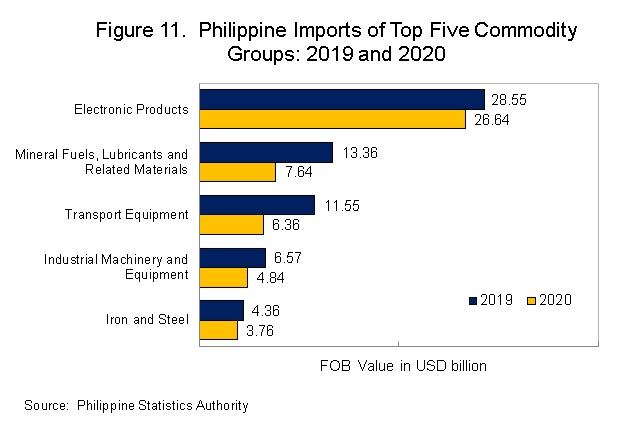
3. Imports of raw materials and intermediate goods contributed the highest
By major type of goods, imports of raw materials and intermediate goods accounted for the largest share of USD 36.16 billion (40.3%) in 2020. Imports of capital goods ranked second with a share USD 29.75 billion (33.1%), followed by consumer goods with USD 15.45 billion (17.2%). (Figure 12 and Table 6)
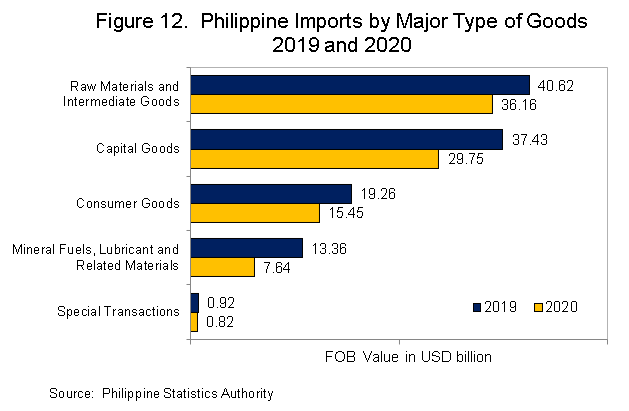
4. People’s Republic of China had the highest import value
The People’s Republic of China was the country’s biggest supplier of imported goods valued at USD 20.87 billion or 23.2 percent of the total imports in 2020.
Completing the top five major import trading partners with their corresponding import payments and percent shares to the total imports were:
a. Japan, USD 8.62 billion (9.6%);
b. USA, USD 6.92 billion (7.7%);
c. Republic of Korea, USD 6.89 billion (7.7%); and
d. Indonesia, USD 5.73 billion (6.4%). (Figure 13 and Table 4)
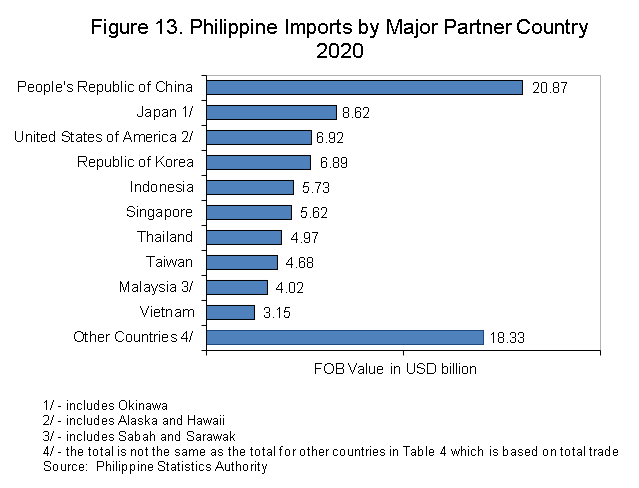
5. Germany topped total imports among EU member countries
The total imports from EU member countries amounted to USD 6.59 billion or 7.3 percent of the total imports in 2020. Import payments from Germany tops the country’s imports from EU member countries at USD 1.97 billion or 29.8 percent of the total imports from EU member countries. (Figure 14 and Table 9)
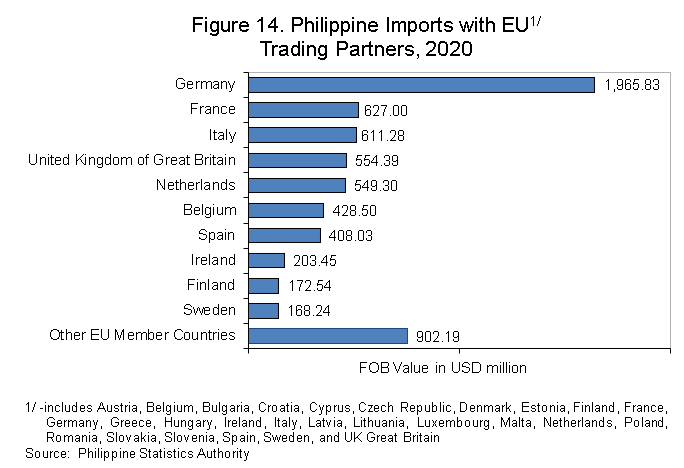
The leading imported goods from EU member countries and their corresponding import payments and percent shares to total EU imports were:
a. electronic products, USD 1.35 billion (20.4%);
b. medicinal and pharmaceutical products, USD 711.55 million (10.8%);
c. transport equipment, USD 655.44 million (9.9%);
d. industrial machinery and equipment, USD 609.19 million (9.2%); and
e. other food and live animals, USD 445.34 million (6.8%). (Table 11)
6. Indonesia led the ASEAN member countries in terms of imports
The total imports from ASEAN member countries was worth USD 23.81 billion or 26.5 percent of the country’s total imports in 2020.
Majority of the imports came from Indonesia and this amounted to USD 5.73 billion or 24.1 percent of the total imports from ASEAN member countries. (Figure 15 and Table 9)
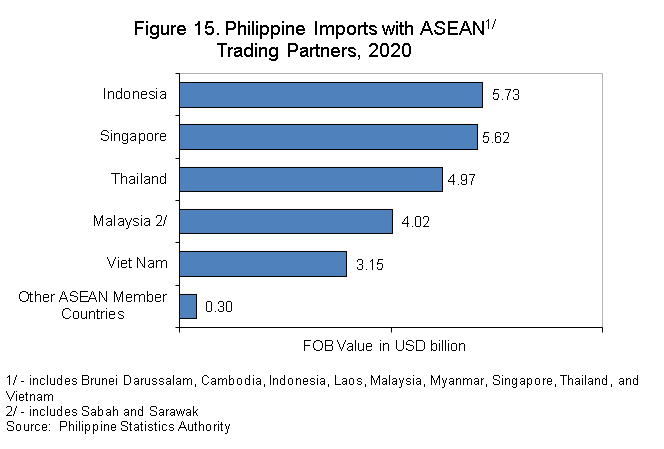
The top five imported goods from ASEAN member countries were:
a. electronic products, USD 4.81 billion (20.2%);
b. transport equipment, USD 3.32 billion (13.9%);
c. mineral fuels, lubricants and related materials, USD 3.03 billion (12.7%);
d. other food and live animals, USD1.59 billion (6.7%); and
e. cereals and cereal preparations, USD 1.09 billion (4.6%).(Table 11)
7. People's Republic of China topped total imports from APEC member countries
Import payments from APEC member countries summed up to USD 77.33 billion or 86.1 percent of the total import. People’s Republic of China registered the highest import value among APEC member countries which amounted to USD 20.87 billion or 27.0 percent of the country’s total imports from APEC member countries. (Figure 16 and Table 12)
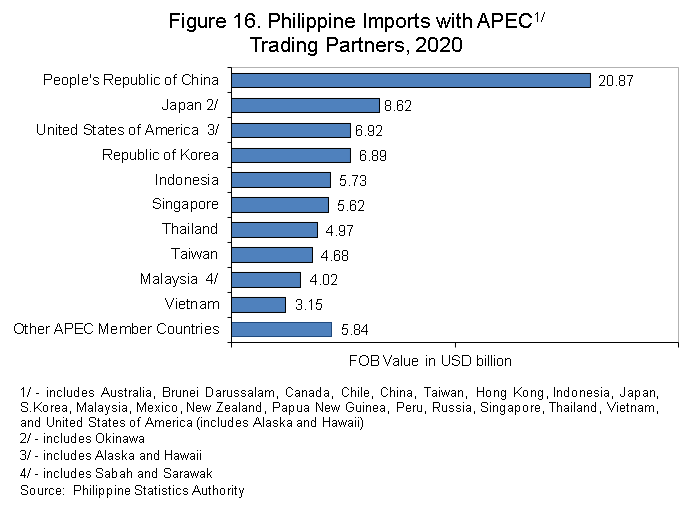
The top five imported goods from APEC member countries and their corresponding import payments and percent shares to total APEC imports were:
a. electronic products, USD 25.04 billion (32.4%);
b. mineral fuels, lubricants, and related materials, USD 5.91 billion (7.6%);
c. transport equipment, USD 5.49 billion (7.1%);
d. industrial machinery and equipment, USD 4.09 billion (5.3%); and
e. iron and steel, USD 3.40 billion (4.4%). (Table 14)
8. Eastern Asia contributed the highest import value by geographic region
By geographic region, USD 43.86 billion of the country’s imports in 2020 went to Eastern Asia. This was followed by South-eastern Asia, with an import value of USD 23.81 billion, and Northern America which valued at USD 7.45 billion. (Figure 17)
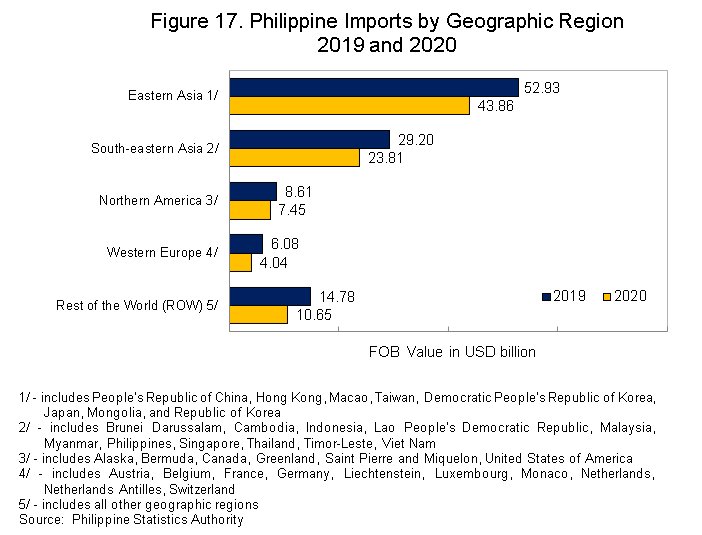
DENNIS S. MAPA, Ph.D.
Undersecretary
National Statistician and Civil Registrar General
EXPLANATORY NOTES
This Special Release features the annual figures for the 2020 export and import statistics of the Philippines. The exports and imports contained in this report are compiled by the Philippine Statistics Authority (PSA) from documents collected from the Bureau of Customs.
The annual export and import trade statistics are released three (3) months after the reference year.
All documents (hard copies and e-files) received within the year 2020, including those documents received from January 2021 to February 2021 with date of lodgement for reference year 2020, are compiled, processed, summarized, analyzed, and disseminated through monthly statistical tables, press releases, and special releases. Processing includes coding, editing, review, and validation of results.
The 2015 Philippine Standard Commodity Classification (PSCC) is used to classify the commodities at 10-digit code level for statistical purposes.
Data requests on international merchandise trade statistics can be made at the PSA, Economic Sector Statistics Service, Trade Statistics Division with telephone number (02) 8376-1975 or email address j.soliven@psa.gov.ph.
